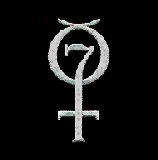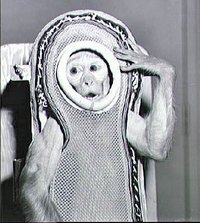Little Joe 2
|
|
For the Apollo program launch vehicle, see Little Joe II.
| Mission Insignia | |
|---|---|

| |
| Mission Statistics | |
| Mission Name: | Little Joe 2 |
| Call Sign: | LJ-2 |
| Number of Crew Members: | 1 primate |
| Launch: | December 4, 1959 Wallops Island |
| Landing: | December 4, 1959 |
| Duration: | 11 min 6 s |
| Number of Orbits: | suborbital |
| Apogee: | 53 mi 88 km |
| Distance Traveled: | 194 mi 312 km |
| Maximum velocity: | 4,466 mph 7,187 km/h |
| Peak acceleration: | 14.8 g (145 m/s²) |
| Mass: | 1,007 kg |
| LJ-2 | |
The Little Joe 2 was an important test of the Mercury capsule because it was the first Little Joe animal flight, carrying the Rhesus monkey Sam (Macaca mulatta) close to the edge of space. He was sent to test the space equipment and the adverse effects of space on humans. His flight was launched December 4, 1959, at 11:15 from Wallops Island, Virginia, United States. The Little Joe 2 flew 55 miles (88 km) into space. It was recovered, with the monkey intact, in the Atlantic Ocean by USS Borie. Sam was one of a series of Monkeys in space. Sam was from the School of Aviation Medicine in San Antonio, Texas. Flight time 11 minutes 6 seconds. Payload 1,007 kg.
The boilerplate Mercury spacecraft used in the Little Joe 2 mission, is currently displayed at Airpower Park and Museum, Hampton, VA.
Mercury Little Joe 2 spacecraft display page on A Field Guide to American Spacecraft website. (http://aesp.nasa.okstate.edu/fieldguide/pages/mercury/LJ-2.html)
See also
| Previous Mission: Little_Joe_1A | Mercury | Next Mission: Little_Joe_1B |

